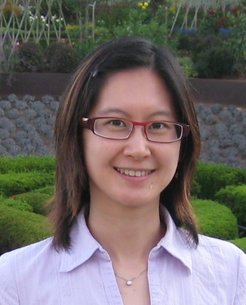Interview with Sherry Suyu, new junior research group leader at MPA
What do you do?
I study galaxies and the history of the universe – its expansion history to be more precise.
Why did you choose this field?
Because I always liked gravitation - I find the topic fascinating! It actually goes way back to high school: There we learned about the way objects in space orbit around each other, like the Earth around the Sun, and this is all based on gravity. But I wanted to probe deeper, to understand how the universe evolved.
Then I learned about a great phenomenon and tool to use: gravitational lensing. This effect produces beautiful images that grab people’s attention, including mine. The lensing effect produces spectacular big arcs and even rings in the sky. And on top this is a great way to study galaxies and cosmology!

And why do you use theory?
When I first approached the topic, there were already several observations of gravitational lenses that had been previously predicted by theory. This proved that these objects are real, that they are in fact out there, and that we can use them to test our theoretical models of cosmology and gain a better understanding of our Universe.
By now we have hundreds of gravitational lens systems – using strong lensing as a tool has indeed become a reality. Soon, with the new surveys and observatories there will be even more: at least thousands of systems.
What are your plans here at MPA?
In our group we will study three things that are all dark:
- Dark Energy, which is the driving force behind the accelerated expansion of the universe;
- Dark Matter in galaxies and the effect it has on their formation and evolution;
- and Supermassive Black Holes at the centres of galaxies, to see how they and their host galaxies co-evolve.
As our tool we use strong gravitational lensing, in particular we use lensed quasars to study all three topics.
These quasars are actually supermassive black holes that are accreting material from their surroundings. During this process they emit huge amounts of radiation, making them into very bright sources from the distant universe. If such a galaxy with a so called active galactic nucleus (AGN) lies behind another massive galaxy it will be lensed and we will see multiple images of the AGN.
As the AGN flux varies over time – accretion is not a homogeneous process – we can see this variability in all multiple images but at slightly different times, because of the geometric path difference the light has to travel for the different images. This time delay is a direct measure of the distance to the source and we can use this measure to study the expansion history of the universe – and how dark energy might influence it.
From the multiple images we can also reconstruct the mass distribution of the galaxy that is acting as a lens. And because the lensing effect depends only on gravity this is a direct probe of the dark matter in the lens galaxy.
Finally, the lensed quasars are powered by supermassive black holes. So from looking in detail at the lensed images, we can also learn something about these very exotic objects.
Currently I’m recruiting both a student and a postdoc, to start building up the group here. One of my students in finishing his PhD in Taiwan, and he will also come and visit over the next few months.
B1608 + 656
Why did you decide to come to MPA?
I’ve been around many places by now, I like to travel…
I was born in Taiwan, grew up in Canada, and went to the US for my PhD. After that I came to Bonn for my first postdoc position; this was actually my first experience in Germany, and I liked it! Then I went back to the US and then back to Taiwan for a faculty position. When I heard about this programme at Max Planck, I applied and was lucky to get this opportunity to come back – so here I am.
There is quite a bit of overlap of my research with what other people are doing at MPA, and this is really a nice opportunity to build a strong lensing research group.
What do you like about Garching/Munich?
MPA is a very active institute and the whole Garching campus is one of the world centres of astrophysics. It is a very active, exciting, stimulating place to be. I visited MPA already in the past and really liked it. It’s nice to be here now and to actually work here.
Munich is a good place to live; it is a very international city. Actually, I found the move to Munich easier than my first move to Bonn/Germany - the transition has been really smooth, thanks to the experience I already had with living in Germany.
